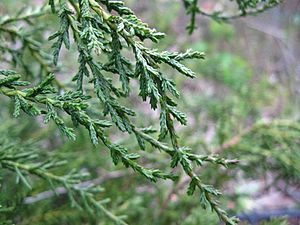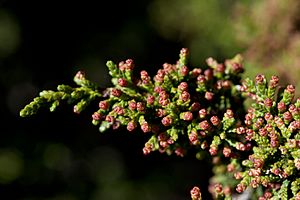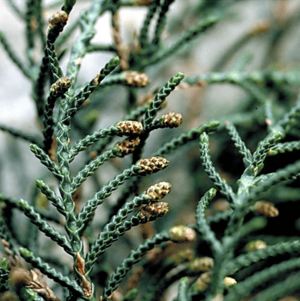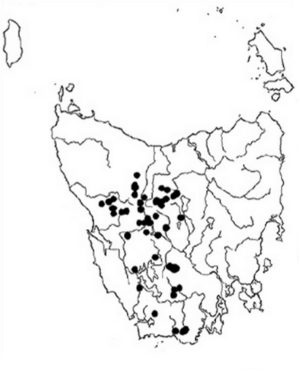Dwarf pine facts for kids
Quick facts for kids Dwarf pine |
|
|---|---|
 |
|
| Conservation status | |
| Scientific classification | |
| Genus: |
Diselma
|
| Species: |
archeri
|
| Synonyms | |
Diselma archeri, also known as the dwarf pine or Cheshunt pine, is a special type of plant. It belongs to the Cupressaceae family, which includes many cone-bearing trees. This plant is the only species in its group, called the genus Diselma.
You can only find Diselma archeri in the high mountain areas of Tasmania's southwest and Central Highlands. It lives in cool, wet places like high-altitude rainforests and damp, open heathlands. Its home is very similar to where other unique Tasmanian cone-bearing plants, like Microcachrys tetragona and Pherosphaera hookeriana, grow.
Contents
What Diselma archeri Looks Like
Diselma archeri is a small, bushy plant that usually grows low to the ground. It often reaches about 1 to 4 meters (3 to 13 feet) tall. But in some rainforest areas, it can grow even taller.
Its leaves are a grey-green color. The tips of its branches often curve downwards. The branches themselves are short and have many ridges. The leaves are small, about 2 to 3 millimeters long, and look like scales. They overlap each other and are arranged in pairs that are pressed close to the stem. If you look at a branchlet from the end, its leaves appear to form a square shape.
The way its leaves are arranged is similar to another plant called Microcachrys tetragona, also known as creeping pine. This can make them hard to tell apart. However, Microcachrys tetragona usually stays very low to the ground. Another plant that looks similar is Phaerosphaera hookeriana. But Diselma archeri can be identified by its unique opposite pairs of leaves.
The bark of Diselma archeri is rough and scaly. It often looks weathered, showing a reddish-brown color underneath.
Reproduction and Cones
Diselma archeri is a gymnosperm. This means it does not produce flowers. Instead, its seeds grow on the surface of special scale-like leaves that form cones.
This plant is also dioecious. This means that male cones and female cones grow on separate plants. Both types of cones are very tiny, only about 3 to 4 millimeters long. They grow at the tips of the branches.
The female cone has two pairs of scales. Only the top pair of scales can produce seeds. When the seeds are ready, up to four small seeds with wings are released. The wind then carries these seeds away. It is not common to see new Diselma archeri seedlings growing from seeds. This plant often regrows from its roots and stems that are buried in the wet soil called peat.
What's in a Name?
The name Diselma comes from two Greek words: dis, meaning "double," and selma, meaning "upper." This might refer to the two fertile scales found in the female cone. Or it could describe how its leaves are arranged in opposite, overlapping pairs.
The second part of its name, archeri, honors a plant collector named William Archer (1820-1874). He was also an architect and a politician in Tasmania.
People often call this plant the dwarf pine because it usually grows low to the ground. It is also known as the Cheshunt pine. This name comes from a property owned by William Archer, even though the plant did not grow there.
Where Diselma archeri Lives
Diselma archeri is found only in Tasmania. It lives in high-rainfall mountain areas in the southwest and Central Plateau of the state. You can find it at heights from about 580 to 1400 meters (1,900 to 4,600 feet) above sea level.
Like many Tasmanian cone-bearing plants, Diselma archeri is very sensitive to fire. It only grows in places that have not been burned. You can find it in open coniferous heath areas and in high-altitude montane rainforests.
In closed rainforests, Diselma can grow into a small tree, reaching 3 to 4 meters (10 to 13 feet) tall. Some scientists even consider Diselma to be one of the seven types of plants that show an area is a true rainforest in Tasmania. In more open heathlands, the dwarf pine grows closer to the ground, usually only 1 to 2 meters (3 to 6 feet) tall.
Its Ancient Family Tree
The closest relatives to Diselma seem to be the Fitzroya plants, which are found in South America. Fitzroya is also a genus with only one species. Both Diselma and Fitzroya belong to a group of plants called Callitroideae, which are found in the Southern Hemisphere.
Scientists have found fossils of both Diselma and Fitzroya in Tasmania. This tells us that Diselma archeri is likely a paleoendemic. This means it is the last remaining species of a group that was once much larger. Over time, as the climate changed, this plant found a safe home in these specific high mountain areas.
See also
 In Spanish: Diselma archeri para niños
In Spanish: Diselma archeri para niños






